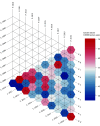Predicting Suicides Among US Army Soldiers After Leaving Active Service
- PMID: 39320863
- PMCID: PMC11425193
- DOI: 10.1001/jamapsychiatry.2024.2744
Predicting Suicides Among US Army Soldiers After Leaving Active Service
Abstract
Importance: The suicide rate of military servicemembers increases sharply after returning to civilian life. Identifying high-risk servicemembers before they leave service could help target preventive interventions.
Objective: To develop a model based on administrative data for regular US Army soldiers that can predict suicides 1 to 120 months after leaving active service.
Design, setting, and participants: In this prognostic study, a consolidated administrative database was created for all regular US Army soldiers who left service from 2010 through 2019. Machine learning models were trained to predict suicides over the next 1 to 120 months in a random 70% training sample. Validation was implemented in the remaining 30%. Data were analyzed from March 2023 through March 2024.
Main outcome and measures: The outcome was suicide in the National Death Index. Predictors came from administrative records available before leaving service on sociodemographics, Army career characteristics, psychopathologic risk factors, indicators of physical health, social networks and supports, and stressors.
Results: Of the 800 579 soldiers in the cohort (84.9% male; median [IQR] age at discharge, 26 [23-33] years), 2084 suicides had occurred as of December 31, 2019 (51.6 per 100 000 person-years). A lasso model assuming consistent slopes over time discriminated as well over all but the shortest risk horizons as more complex stacked generalization ensemble machine learning models. Test sample area under the receiver operating characteristic curve ranged from 0.87 (SE = 0.06) for suicides in the first month after leaving service to 0.72 (SE = 0.003) for suicides over 120 months. The 10% of soldiers with highest predicted risk accounted for between 30.7% (SE = 1.8) and 46.6% (SE = 6.6) of all suicides across horizons. Calibration was for the most part better for the lasso model than the super learner model (both estimated over 120-month horizons.) Net benefit of a model-informed prevention strategy was positive compared with intervene-with-all or intervene-with-none strategies over a range of plausible intervention thresholds. Sociodemographics, Army career characteristics, and psychopathologic risk factors were the most important classes of predictors.
Conclusions and relevance: These results demonstrated that a model based on administrative variables available at the time of leaving active Army service can predict suicides with meaningful accuracy over the subsequent decade. However, final determination of cost-effectiveness would require information beyond the scope of this report about intervention content, costs, and effects over relevant horizons in relation to the monetary value placed on preventing suicides.
Conflict of interest statement
Figures



Comment on
-
Actualizing Military Suicide Prevention Through Digital Health Modernization.JAMA Psychiatry. 2024 Dec 1;81(12):1173-1174. doi: 10.1001/jamapsychiatry.2024.2679. JAMA Psychiatry. 2024. PMID: 39320870 No abstract available.
References
-
- Shen YC, Cunha JM, Williams TV. Time-varying associations of suicide with deployments, mental health conditions, and stressful life events among current and former US military personnel: a retrospective multivariate analysis. Lancet Psychiatry. 2016;3(11):1039-1048. doi: 10.1016/S2215-0366(16)30304-2 - DOI - PubMed
-
- Federal Register . Supporting our veterans during their transition from uniformed service to civilian life. Accessed August 16, 2024. https://www.federalregister.gov/documents/2018/01/12/2018-00630/supporti...
-
- US Secretary of Veteran Affairs; US Secretary of Homeland Security . Joint action plan for supporting Veterans during their transition from uniformed service to civilian life. Accessed August 16, 2024. https://www.va.gov/opa/docs/joint-action-plan-05-03-18.pdf
Publication types
MeSH terms
Grants and funding
LinkOut - more resources
Full Text Sources
Medical

